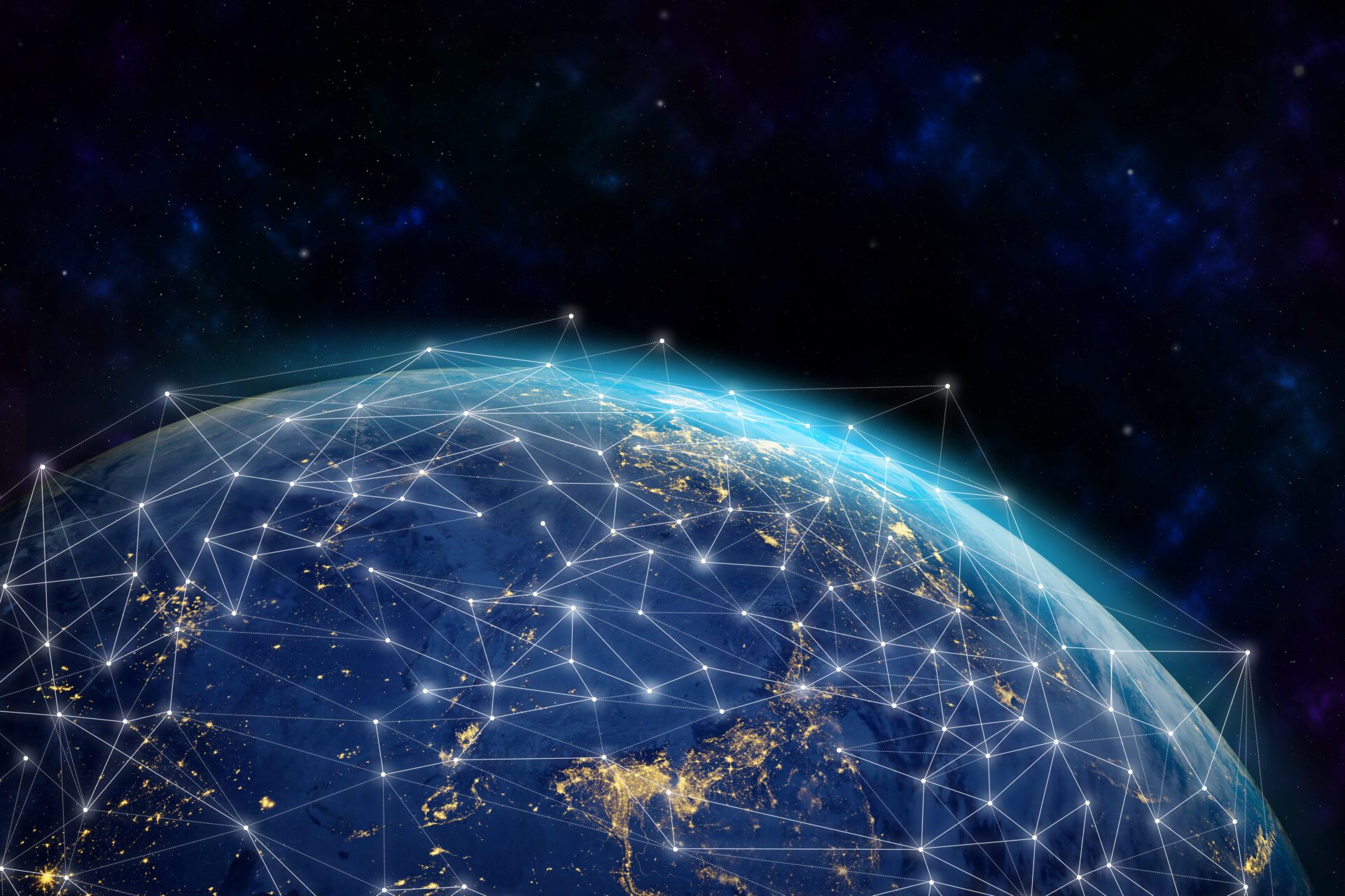
The Physical Internet in logistics: The idea of cooperation
In this article, you will learn:
-
what is the Physical Internet in logistics?
-
what are the benefits of logistics networks within the Physical Internet?
-
what is the ALICE platform implemented by the European Union, and what are its key areas?
-
what challenges concerning Physical Internet will we face in the future of logistics?
-
what are the key technologies that will help implement the Physical Internet in the transportation industry?
Physical Internet concept
The Physical Internet in logistics is a concept based on utilizing the infrastructure idea associated with the digital Internet to manage and optimize the flow of materials, goods, and information within logistics processes. This enigmatic concept in the transportation industry seeks to mirror the way data packets are transmitted in the virtual world. For example, when sending an online message to someone in another country, we only cover the service cost of our Internet provider, not considering how many local operators, servers, or fiber optics our email encounters. The digital shipment simply reaches the recipient efficiently thanks to the open space of free data transmission.
Now imagine logistics adopting the described functioning manner. Then, the sender would use publicly available infrastructure or any carrier's vehicles, and an advanced IT system would determine the optimal route for him. Ordered goods would then be packaged in standardized units (similar to data packets on the Internet), facilitating their movement, storage, and delivery.
Adapting the operation of the digital Internet in the transportation sector would allow for a more efficient, effective, and optimal scenario for logistics operations. This Physical Internet initiative would enable deliveries to be made optimally, considering factors such as time, costs, or environmental harm.
Watch the video presenting the concept of the Physical Internet.
Why is the Physical Internet concept so crucial to obtaining efficient transport?
Since moving goods along the global supply chain is inevitable, implementing the “Physical Internet” on a full scale would be a solution for the problems presented below:
- inefficiency of deliveries and unused space resulting from partially loaded vehicle departures from subsequent unloading points,
- low throughput of transportation and logistics systems,
- reduced profitability for both the manufacturer and the logistics service providers,
- the costly nature of efficient transportation due to the lack of available products in the nearest warehouse,
- the rise in popularity of e-commerce,
- the negative impact of road transport on the environment – air pollution with CO2 and greenhouse gas emissions (see the chart below).

From the chart above, we see that transport generates 1/4 of greenhouse gas emissions in the European Union — with road accounting for 71%. Therefore, there is a strong need to find a logistics management solution that would increase freight efficiency while maintaining economic and environmental balance — and such a concept is offered by the Physical Internet. Combining this idea with automated storage and retrieval systems (ASRS) would further increase warehouse operation efficiency, thereby accelerating the issuance of goods for transport.
How does the Physical Internet benefit logistics?
- Supply chain optimization: Thanks to the Physical Internet concept, goods can be transmitted via the optimal route at any given moment, considering current road conditions, weather, and other factors affecting delivery time.
- Efficient transport and reduced logistics costs: Standardization of processes and the use of shared logistics resources lead to increased operational efficiency, cost reduction, and delivery time shortening.
- CO2 emission reduction: By minimizing the number of empty runs and optimizing routes, the Physical Internet contributes to reducing carbon dioxide emissions, crucial for combating climate change.
- Flexibility and scalability: Thanks to dynamic adaptation to changing needs and conditions, the Physical Internet allows flexibility in supply chain management and scalability of logistics operations.
Physical Internet vision — European Union support
The European Union is conducting activities related to the development of the Physical Internet through the European Technology Platform ALICE (Alliance for Logistics Innovation through Collaboration in Europe). This project was created as part of the European Initiative for Zero-Emission Vehicles (European Green Cars Initiative). The concept's goal is to develop and then implement a comprehensive industry strategy in terms of research, innovation, and market implementations in logistics and supply chain management in Europe.
The ALICE platform is based on recognizing the need for a cohesive approach to planning and supply chain management. In this model, carriers and operators closely cooperate to increase the efficiency of logistics services in transport and reduce greenhouse gas emissions.
Watch the video to learn more about the vision of the ALICE platform regarding the Physical Internet.
Selected key trends of the Physical Internet
The European Union plans a complete logistics network system of the Physical Internet by 2040. The ALICE project strategy includes areas such as:
1. Standardized packages, systems, and logistics nodes — common procedures, regulations, and logistics standards
A common logistics and transportation system would increase the capabilities of logistics companies through the idea of resource sharing between organizations. By joining the global transport system, we could mutually share transport routes and nodes. Additionally, thanks to standardization, it would be possible to handle packages in any sorting center, track them through a global website in real-time, or transport them by any courier's truck. The modularization of cargo units would maximize the use of transport space and increase the efficiency of transport operations while reducing costs and negative environmental effects.
2. Globalization of logistics — a global open supply chain network of logistics operations
Imagine common warehouses for logistics companies. In this way, different products would be available in more locations, and ordered products would reach us faster, traveling a shorter distance. Just like in the digital Internet, which delivers both Google search and Netflix movies, even though these are two separate companies, their content reaches us through the same data transmission channel. Hence, globalization would allow the translation of the philosophy of the virtual world into the physical transport of goods, eliminating unnecessary infrastructure and using the remaining more efficiently.
3. Modern technologies — an advanced management system for the logistics chain within the Physical Internet available to logistics network owners
Creating a system of interconnected transport networks and spreading it worldwide increases the transport capabilities of logistics companies. With agreed agreements, an intelligent solution would allow mutual use of infrastructures and enable automatic transfer between operators of shipments in such a way that they reach recipients most efficiently, taking into account various factors. Similar to how it works in the traditional Internet, when entering Google's website address – www.google.com, we end up exactly where we planned. The Physical Internet would also increase the reach, quality, and efficiency of deliveries.

Challenges and Future
Despite numerous advantages, the implementation of the Physical Internet in logistics also comes with certain challenges. It is necessary to develop logistical standards, common norms and regulations, and plan investments in logistics supply chain infrastructure. Additionally, there are concerns about data security and the need for education and training for transportation industry employees. Another issue is the change in companies' attitudes towards cooperation and the concept of collaborative activity for mutual benefits.
The development of technology, including the Internet of Things (IoT), Artificial Intelligence (AI), and data analysis, allows for increasingly advanced and automated supply chain management, which favors the idea of the Physical Internet. However, there is a need for pilot tests that will show that the Physical Internet will bring the described benefits, which will gather supporters around this idea and build trust in the project being implemented.
The Physical Internet has the potential to become an integral part of the global logistics infrastructure in the future, contributing to more sustainable and efficient movement of goods worldwide. Therefore, continuing research on the Physical Internet is extremely important for the more efficient development of the logistics industry and sustainable social and economic development.
Summary
The Physical Internet, as a new stage in the development of the transport network, aims to establish universal frameworks for cooperation in an open logistic environment. Its goal is to ensure the full flow of information and collaboration without limitations, which requires a change in approach, standardization, globalization, and intelligent solutions. Pilot tests are crucial for justifying further investments to enable efficient deliveries in the future, reduce negative environmental impacts, and increase profitability for manufacturers and carriers, ensuring fast package delivery to customers.

Would you like to implement optimized warehouse management? Let us know!
As an integrator of automation and robotics solutions, we are responsible for the comprehensive implementation of automated warehouse projects and intralogistics systems. Combining unique engineering competencies, we build advanced solutions for the industry and logistics, tailoring the project to meet the individual requirements of the client.